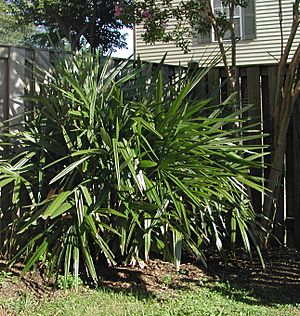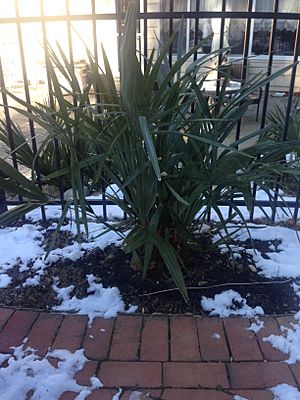Needle palm facts for kids
Quick facts for kids Needle palm |
|
|---|---|
 |
|
| Specimen planted in a Maryland back yard | |
| Conservation status | |
| Scientific classification | |
| Genus: |
Rhapidophyllum
|
| Species: |
hystrix
|
| Synonyms | |
|
|
The needle palm (scientific name: Rhapidophyllum hystrix) is a special kind of palm. It is the only member of its group, called Rhapidophyllum. This palm naturally grows along the coasts of the southeastern United States. You can find it from South Carolina down to Florida and west into Mississippi and southern Alabama.
The needle palm is known for being one of the toughest palms in the world. It can handle very cold weather! This makes it a popular plant in places with warm but sometimes chilly climates.
This palm grows in a bushy shape, with many stems coming from one base. These stems grow very slowly and close together. They form a thick base about 1 to 1.2 meters (3 to 4 feet) tall. The plant has many sharp, needle-like spines between its leaves. These spines are 10 to 25 centimeters (4 to 10 inches) long. They help protect the plant from animals that might try to eat it. The whole plant can reach 2 to 3 meters (7 to 10 feet) tall.
The needle palm is a type of fan palm. Its leaves have a long stem, called a petiole. This stem ends in a round fan shape with 8 to 16 smaller leaf parts. Each leaf can be up to 2 meters (7 feet) long. The smaller leaf parts are about 60 to 80 centimeters (24 to 31 inches) long. The palm's flowers grow in thick, short bunches at the top of the stems. Usually, male and female flowers grow on separate plants. The fruit is a brown, round fruit called a drupe, which is about 2 centimeters (0.8 inches) long.
The scientific name Rhapidophyllum means "needle-leaf." The word hystrix comes from the name for a group of porcupines. Both names refer to the sharp, needle-like spines on the palm. Because of these spines, it is sometimes also called the "porcupine palm."
Growing Needle Palms
The needle palm is very popular with people who love palms. This is because it can handle cold weather better than most other palms. Some reports say it can survive temperatures as low as -26 degrees Celsius (-15 degrees Fahrenheit). However, it might get badly damaged and then recover. More often, it can handle about -21 degrees Celsius (-5 degrees Fahrenheit) with some leaf damage.
Needle palms need hot summers to grow well. They do not grow as well in places with cool summers, like the Pacific Northwest (USA/Canada) or parts of Northwest Europe.
Where Needle Palms Grow in the USA
In the United States, needle palms are grown far north along the East Coast, up to Long Island Sound. On the West Coast, they grow as far north as Seattle, Washington. Some large, old needle palms have been growing in Tennessee and the southern Ohio Valley for a long time. There are also well-known palms at the United States National Arboretum in Washington, DC since the 1960s. More recently, they have been planted in the coastal NYC area, like at the Brooklyn Botanic Gardens. It is now a very popular palm for gardens in the Chesapeake Bay area of Maryland.
Protecting Needle Palms
The needle palm is considered a threatened plant because too many are taken from the wild. When you want to buy a needle palm, it is important to buy it from a trusted seller. This helps make sure the palm was grown in a nursery and not taken from its natural home.
See also
 In Spanish: Rhapidophyllum hystrix para niños
In Spanish: Rhapidophyllum hystrix para niños




